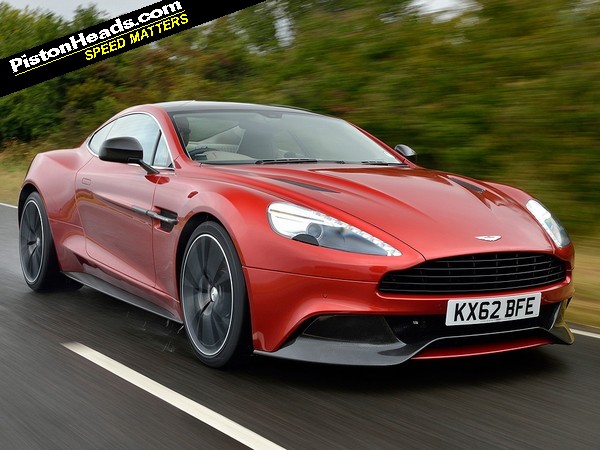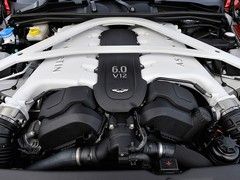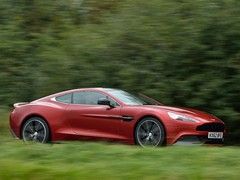Driven: Aston Martin Vanquish
Sharper, all carbon skin and quantifiable engineering improvements beneath but is the new Vanquish actually better?

This should be the most well developed modern Aston ever, then. It certainly looks it. Images don’t do justice to the near-iridescence of the surfaces – designer Marek Reichman says the depth of the rear haunches and sharp creases throughout wouldn’t be possible in aluminium and describes the impression as the difference between rolling mountain hillsides and sheer alpine ranges. Unlike many recent ‘new’ Astons, it does evolve the DB9-derived theme we’re familiar with and you’ll tell it apart from other Astons in an instant.
Same old same old?
There’s too much that’s familiar inside, mind – dials and 1970s fly-off handbrake spring to mind – but at least the footwells are bigger and the haptic feedback centre console fancier - it clicks like an iPhone when you touch it. You’ll still curse the key too (press in and hold…) but, boy, is there a reward when it catches.
Now producing 573hp, the 6.0-litre V12 boasts an exhaust system developed from the One-77 that sounds immense. It blares powerfully even at idle – it’s not dependent on accelerating gases to create its harmony – and is every bit as rich as you’d hope. Turn it up further by jabbing the glowing red ‘S’ sport button on the steering wheel.
The engine is nine per cent more powerful, nine per cent more economical and, significantly, now has dual variable valve timing so there’s more torque lower down in the rev range, compensating for the holes in the gearbox’s ratios. It’s still not a slugger but it now has more of the response you’d expect of a 6.0-litre motor at cruising revs and now gets into its stride at 3,000rpm rather than 4,500rpm. The howl at redline revs is brilliant.
Off the line
At 4.1 seconds, it’s 0.2secs faster to 62mph albeit slower overall, presumably due to the downforce-inducing aeroduct rear. There’s a new launch control to help make this repeatable, albeit a pretty soft and undramatic one.
The six-speed ZF gearbox is perhaps at fault here. It’s neither as snappy as a good DCT nor as expansive as the latest eight-speed unit. This is the Vanquish’s weakest area.
Three-stage adaptive damping (controlled by another steering wheel button) and 25 per cent greater torsional rigidity have appreciably improved the DBS’s ride quality. The chassis is now more supple and it’s tuned to use a wide range of wheel travel where necessary, yet is damped well enough to never seem loose.
Handling is also sharper though – an extra stage of adaptivity means the car’s breadth is wider and Aston’s added more tautly-controlled focus in the sportier reaches. Wider tyres mean traction is superb and it can be chucked about like a much smaller car with real confidence: this is a very easy and natural car to drive.
Getting the jitters
Just one proviso – the Cambridgeshire test route created a very sharp and jittery Vanquish in places. The roads were disgracefully bad, yes, but whether Aston’s gone too far here must wait until we get it on familiar roads.
The steering is less chatty than before. Perhaps inevitable: the classic 911-style on-centre squirm of the DBS is a bit old-school now, and the Vanquish trades this for more positive bite to micro-inputs. It’s still a fine system, but in making it ‘better’, it’s become a bit less charismatic.
Other areas still feel like a racecar though, from the standard carbon ceramic brakes to the feeling of mass centralised even more within the chassis. It is - the engine is 19mm lower and the hollow cast aluminium front chassis is 13 per cent lighter than the DBS. It feels more of a specialist car than a 911 or a Conti GT, just one that’s now better to look at, live with and to drive. Although, at £190K, priced accordingly too…
The philosophy of VH means the Vanquish doesn’t feel a radical diversion. Rightly or wrongly, we shouldn’t expect otherwise. Rather, it’s a better version of what went before. Only now, at last, it also looks like it, too…
ASTON MARTIN VANQUISH
Engine: 5,935cc, V12
Transmission: 6-speed ZF automatic, rear-wheel drive
Power (hp): 573@6,750rpm
Torque (lb ft): 457@5,500rpm
0-62mph: 4.1 sec
Top speed: 183mph
Weight: 1,739kg
MPG: 19.6
CO2: 335g/km
Price: £191,080
Gassing Station | General Gassing | Top of Page | What's New | My Stuff








